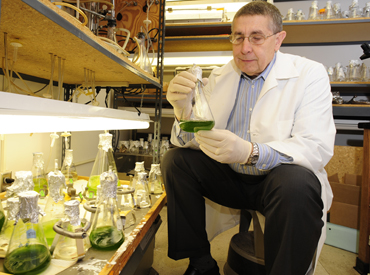Iowa State University scientists genetically increase algae biomass by more than 50 percent
11-21-11
 Martin
Spalding, professor in the Department of Genetics, Development,
and Cell Biology and associate dean for research and graduate
studies in the College of Liberal Arts and Sciences, is leading
a team that discovered a genetic method that can increase
biomass in algae by 50 to 80 percent.
Martin
Spalding, professor in the Department of Genetics, Development,
and Cell Biology and associate dean for research and graduate
studies in the College of Liberal Arts and Sciences, is leading
a team that discovered a genetic method that can increase
biomass in algae by 50 to 80 percent.
ISU photo by Bob Elbert
Contacts:
Martin Spalding, Genetics, Development and Cell Biology,
515-294-7740, mspaldin@iastate.edu
Dario Valenzuela, Intellectual Property and Technology Transfer, 515-294-4470, dariov@iastate.edu
Dan Kuester, News Service, 515-294-0704, kuester@iastate.edu
Iowa State University scientists genetically increase algae biomass by more than 50 percent
AMES, Iowa - Research at Iowa State University has led to discovery of a genetic method that can increase biomass in algae by 50 to 80 percent.
The breakthrough comes from expressing certain genes in algae that increase the amount of photosynthesis in the plant, which leads to more biomass.
Expressing genes means that the gene's function is turned on.
"The key to this (increase in biomass) is combination of two genes that increases the photosynthetic carbon conversion into organic matter by 50 percent over the wild type under carbon dioxide enrichment conditions," said Martin Spalding, professor in the Department of Genetics, Development, and Cell Biology and associate dean for research and graduate studies in the College of Liberal Arts and Sciences.
Carbon enrichment conditions are those in which the algae has enough carbon dioxide.
This patent-pending technology is available for licensing from the Iowa State University Research Foundation, which also provided technology development funds.
This opens up possibilities for more and better biofuel development, according to Spalding.
"There is no doubt in my mind that this brings us closer [to affordable, domestic biofuel]," said Spalding.
In nature, algae are limited from growing faster because they don't get enough carbon dioxide from the atmosphere, according to Spalding.
In environments that have relatively low levels of carbon dioxide (CO2), such as air in earth's atmosphere, two genes in algae, LCIA and LCIB, are expressed - or turned on - to help capture and then channel more carbon dioxide from the air into the cells to keep the algae alive and growing.
However, when algae are in environments with high carbon dioxide levels, such as in soil near plant roots that are expiring carbon dioxide, the two relevant genes shut down because the plant is getting enough carbon dioxide.
The process is similar to a car driving up a hill. The accelerator - these two genes - is pressed and the engine works hard to climb a hill. But when going down an incline, the driver often lets up on the accelerator since more gas isn't needed - the genes shut down.
The two genes are expressed - essentially keeping algae's foot on the gas - even when they are in a carbon dioxide-rich environment and don't need additional carbon dioxide.
Research by Spalding's group shows that algae can be made to produce biomass with the accelerator floored, even in conditions where it would normally just coast, Spalding said.
"Based on some prior research we had done, we expected to see an increase, probably in the 10 to 20 percent range" he said. "But we were surprised to see this big of an increase."
In experiments to get the algae type (Chlamydomonas reinhardtii) to produce more biomass, Spalding first expressed LCIA and LCIB separately. Each effort granted a significant 10 to 15 percent increase in biomass.
When the two genes were expressed together, Spalding was surprised to see the 50 to 80 percent biomass increase.
"Somehow these two genes are working together to increase the amount of carbon dioxide that's converted through photosynthesis into biomass by the algae under conditions where you would expect there would already be enough carbon dioxide," said Spalding.
The excess biomass naturally becomes starch through the photosynthesis process, and increases the biomass starch by around 80 percent.
By using some existing mutated genes, Spalding can instruct the algae to make oil instead of starch. This process requires more energy and the process results in around a 50 percent increase in oil biomass.
Spalding's research was funded in part by grants from the
Department of Agriculture's National Institute of Food and
Agriculture and the Department of Energy, Advanced Research
Projects Agency - Energy.
-30-
